practice or practise - To repeat an action or process to acquire or refine a skill, or to improve ones abilities in an art, a craft, or other pursuit. Or, to do something as an established custom or habit.
"Practice" can be a noun as well: something a person does repeatedly, whether to improve or to do what one does customarily, habitually, or professionally. Writers occasionally refer to what artists do as their practice: "Duchamp's practice" or "Picasso's studio practice." Some prescriptivists have criticized this usage as pretentious. The stronger tradition is to speak of the practices of physicians, lawyers, and dentists. Those professionals must have licenses in order to practice. They are white collar, and less messy. Speaking of an artist's "practice" is somewhat comparable to speaking of an artist's "production" — art making. "Production" appears to be redeemed its association with industrial labor.
"Practise" is the British spelling.
Quote:
Also see art careers, contour drawing, gesture drawing, practitioner, teacher, and technique.
practitioner - In education, a synonym for an educator — one who teaches as a profession. This term is often used instead of the term teachers in order to include administrators and other educators who might otherwise feel left out.
practitioner research - See action research.
Prairie Style or Prairie School
 Praxis - The Praxis Series is an Educational Testing Service
(ETS) program that provides tests and other services for states
to use as part of their teacher certification process. The Praxis
Series assessments are also
used by colleges and universities to qualify individuals for entry
into teacher education programs. A number of professional associations
and organizations also use these tests. There are separate Praxis
tests for each of several disciplines. In 2003 there are three
different specialty area tests in visual arts: "Art Making,"
"Art Content Knowledge," and "Art Content, Traditions,
Criticism, and Aesthetics." ArtPage is an excellent resource
for those preparing for these tests, because it cross-references
information about art media,
tools and techniques,
art history, criticism,
aesthetics, and other art education
topics.
Praxis - The Praxis Series is an Educational Testing Service
(ETS) program that provides tests and other services for states
to use as part of their teacher certification process. The Praxis
Series assessments are also
used by colleges and universities to qualify individuals for entry
into teacher education programs. A number of professional associations
and organizations also use these tests. There are separate Praxis
tests for each of several disciplines. In 2003 there are three
different specialty area tests in visual arts: "Art Making,"
"Art Content Knowledge," and "Art Content, Traditions,
Criticism, and Aesthetics." ArtPage is an excellent resource
for those preparing for these tests, because it cross-references
information about art media,
tools and techniques,
art history, criticism,
aesthetics, and other art education
topics.
precursor - One that precedes and indicates or suggests something to come. A forerunner or predecessor. For example, the Romantic works of James M.W.Turner (English, 1775-1851) were precursors of both Impressionism and Expressionism. The magic lantern is a precursor to cinematography and video. Alternatively, a precursor is a profane toddler.
predella - In church architecture, the narrow ledge on which an altarpiece rests on an altar.
prehistoric - See Stone Age.
premise - A proposition upon which an argument is based or from which a conclusion is drawn; a stated assumption.
Also see deduction and syllogism.
preparator - Among those people in art careers, an art museum preparator performs or supervises the performance of duties involving the handling of art objects for a variety of purposes including exhibitions, research and teaching, and assists curators in the maintenance of collections.
Depending on its size and needs, a museum typically employs preparators at one to three levels. The titles of positions at three levels are: principal preparator, senior preparator, and preparator.
A principal or head preparator supervises the activities of other preparators, and performs the most technical, skilled preparatory work with museum collections, including assisting in conservation and restoration projects, in consultation with appropriate museum scientists or administrators; maintains collections according to museum classification or storage systems; and coordinates the installation of art exhibitions. A principal museum preparator might perform limited research on museum materials or exhibit projects, and may serve as a docent to visitors and present talks to school groups by introducing students and scholars to a collection. A principal museum preparator typically directs and coordinates the installation schedule of art exhibitions in several galleries; advises the curatorial staff on installation methods, and initiates new methods. A principal museum preparator bears responsibility for the safe handling of all works of art in the museum.
A senior museum preparator serves at the operational level in performing preparatory work, performing conservation and restoration, including the cleaning of objects for exhibition; sorts, arranges, and integrates art objects into classification or storage systems; conditions and installs works of art; and assembles and re-files art objects, including checking items returned from loan for possible damage. A senior museum preparator typically receives, conditions, mats, unmats, mounts, cleans, frames and stretches, installs, packs, ships, and records the location of works of art in all media; uses a wide variety of tools, hardware and equipment; and acts as security guard during installation projects.
A museum preparator typically performs manual work involving the transfer of art objects within a museum, and for special exhibit layout; assists in the layout of art objects for exhibition programs and research projects; packs, unpacks and prepares shipments; assists in inventory and other collections work, including the typing of storage labels; assists in the arrangement of art objects within collections study and storage areas; assists in the construction of exhibit cases (vitrines, pedestals and other means of display) and the painting of panels, backgrounds, etc.; and assists in the maintenance of inventory records.
This definition is largely drawn from a description of the museum preparator position published by the University of California, Los Angeles in 1976.
Also see director, donor, fumigation, Material Safety Data Sheet (MSDS), museology, patron, and registrar.
preschematic stage - The second of the Stages of Artistic Development named and described by Victor Lowenfeld, it typically occurs in children during the ages of 4 to 6. This stage is typically preceded by the scribble stage and followed by the schematic stage (6-9). Others refer to the preschematic and schematic stages as the period of symbolism.
Related links:
Also see children's art.
press molding - A method of casting, especially ceramic ware by pressing a sheet of clay, by hand or with a tool, into an open plaster mold.
Also see release agent.
pretentious - Claiming or demanding an unjustified position of distinction or merit. Displaying extravagance. Other synonyms: ostentatious, phony, snobbish, pompous, flashy, flaunting, florid, turgid, bombastic, swaggering, strutting, peacockish, grandiose, grandiloquent, highfalutin, orotund, and orchidaceous [an extravagant word itself!].
However appropriate it may be, to criticize a person or thing for being pretentious is accusatory. Caution!: Most people are averse to ostracism. Unless an odious motive can be identified, one may be wise to employ less accusatory terms in describing a person or thing that is simply odd. Consider alternatives: e.g., strange, weird, peculiar, eccentric, or quirky. It is inappropriate to use even these without making (or at least preparing) a case for their use.
The opposite of pretentious: modest, reserved, inconspicuous, plain, simple. For example, Shaker furniture is never pretentious.
Quote:
Also see bad art, buckeye, ersatz, fake, gild the lily, kitsch, low art, mass media, flamboyant, baroque, rococo, sublime, and truth.
pretty - Generally superficial beauty.
Examples (each showing prettiness along with other traits):

Pierre Auguste Renoir (French, 1841-1919),
The
Dancer, 1874, oil
on canvas, 56 1/8 x 37 3/8
inches, National Gallery of Art, Washington, DC.
![]()

German? Polish? American?, Easter Bunny on Easter Eggs, c. 2002,
polychromed blown and molded
glass, glitter,
height 5 inches, $49.50 US
retail price. See kitsch.

Robert Tanner Doll Company, American, Betsy McCall Doll,
wearing the "Pretty and Perky Outfit," 2003, mixed
media, height c. 12 inches.
Also see aesthetics, beauty, collectible, cute, feminism and feminist art, kitsch, nice, positive, and praise.
price - The amount demanded or paid for (not to be confused with the art term value) for an art object, writing, intellectual property, etc., which is largely the same as its market value or monetary worth. Knowing an earlier price for something can help in setting a new price for it, or to appropriately insure it, or to satisfy simple curiosity. How a price is set might be determined by an appraisal, or by offering it for sale either via auction or gallery (traditional or online), or by an advertisement placed in a newspaper or magazine. [A much more in-depth article on this subject is coming soon.]
About buying and selling art:
Internet resources concerned with price:
Also see bad-debt art, collectible, commission, and commodity.
primary  colors - The colors
yellow, red (magenta), and blue (cyan) from which it is possible
to mix all the other colors of the spectrum
— also known as the subtractive or colorant primaries. Thus pigments that reflect light
of one of these wavelengths
and absorb other wavelengths may be mixed to produce all colors.
Also, the light (-source) primaries: Lights of red, green, and
blue wavelengths may be mixed to produce all colors. Light primaries
are used in theatrical stage lighting, and in color video
and computer screens.
colors - The colors
yellow, red (magenta), and blue (cyan) from which it is possible
to mix all the other colors of the spectrum
— also known as the subtractive or colorant primaries. Thus pigments that reflect light
of one of these wavelengths
and absorb other wavelengths may be mixed to produce all colors.
Also, the light (-source) primaries: Lights of red, green, and
blue wavelengths may be mixed to produce all colors. Light primaries
are used in theatrical stage lighting, and in color video
and computer screens.
An example of art in which the primary colors are important:
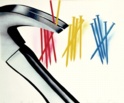
James Rosenquist (American, 1933-), Pulling out, 1972, color lithograph, 26/39, 65 cm x 76.5 cm,
Tehran Museum of Contemporary Art, Iran. Rosenquist pictures
a claw hammer pulling nails that he's rendered
in the primary colors. See Pop
Art.
Also see CMYK, RGB, and secondary colors.
primer - An undercoating paint applied to a surface, sealing it, creating a better bond (adhesion), and providing a ground for a painting. Applying such a ground is called priming.
(pr. PRI:-mər)
Also see gesso, stain, and stain removal.
primitive - Early or undeveloped; simple. Caution: what one person interprets as primitive is likely to be interpreted by some as sophisticated in other ways. Such things are relative. Some prefer the term "primal." Primitive should not be confused with naive, folk, or outsider art, although some artists have intentionally made art so that it will display qualities of primitive art.
Examples of this last type of primitive work:

Michel Larionov (French, born Russia, 1881-1964),
Spring, 1912, oil
on canvas, 86.5 x 68.2 cm,
Georges Pompidou Center, Paris. See Rayonism
and Russian art.
![]()

Jean Dubuffet (French, 1905-1985), Dhôtel nuancé d'abricot (Dhôtel
in Shades of Apricot), 1947, oil
on canvas, 116 x 89 cm, Centre
Georges Pompidou, Paris.
Quote:
Also see Aboriginal art, African art, basket, ceramics, charm, civilization, dance, ethnic, fetish, fine art, mask, metal, shaman, shamanism, and textile.
principles of design or principles of art - Certain qualities inherent in the choice and arrangement of elements of art in the production of a work of art. Artists "design" their works to varying degrees by controlling and ordering the elements of art. Considering the principles is especially useful in analyzing ways in which a work is pleasing in formal ways. How any work exhibits applications of these principles can further or modify other characteristics of a work as well.
Some principles overlap or oppose others, and some are viewed as more important, more ideal, more relevant or irrelevant (or even undesirable) than others. So it is understandable that various authorities' lists of principles differ one from another. Several authorities do not include the concepts marked here with an asterisk (*). The primary reason for this variation appears to be disagreement about whether principles are ideals — concepts found in the best designs / art — or design issues we benefit from understanding and considering in order to more thoughtfully produce, understand, and judge art and design. The trend is toward the second point of view. After all, there are needs for both the beautiful and the grotesque, the polished and the rough, and exceptions to many rules.
See articles about each of the principles of design / art:
Also see allover, decoration, expression, interesting, and music.
prism - A three-dimensional figure whose bases or ends have the same size and shape and are parallel to one another, and each of whose sides is a rectangle. A transparent solid of this form, typically of glass and usually with triangular ends, used for separating white light passed through it into a spectrum, or for reflecting light beams. And, ground-glass objects such as those used as components of crystal chandeliers. Also, used metaphorically to refer to a medium that misrepresents whatever is seen through it.
Also see optical and triangle.
prismatoid - A polyhedron all of whose vertices lie within one of two parallel planes. The minimum number of faces it must have is four, the maximum number possible is unlimited.
Also see mathematics, polygon, prism, and vertex.
problem - A situation or question that presents perplexity, or a challenge, a mystery or puzzle which begs to be solved. In art education, assignments are often posed as problems. To students of creativity, finding or formulating a problem is considered the first stage in the creative process. George Kneller (American psychologist) called this stage "first insight." A middle stage involves mulling over the problem in a sort of chaos of ideas and knowledge. Jacob Getzel (American psychologist) called this "incubation." The last stage is when the idea is tested as a potential solution to the problem. Getzel called this "verification."
Quote:
Also see program.
process - A complex operation involving a number of methods or techniques, such as the addition and subtraction processes in sculpture, the etching and intaglio processes in printmaking, or the casting or constructing processes in making jewelry.
Also see albumen printing, analog, aquatint, art therapy, banco, benday, censorship, chasing, CMYK (cyan magenta yellow black), collage, coning, creativity, curing, daguerreotype, digital imaging, drypoint, earth art, electroplating, encaustic, etching, excavating, extruding, ferrotype, fire gilding, galvanizing, isms, jade, lossless and lossy compression, mezzoprint, montage, negative, offset printing, optical mixing, papermaking, pasteup, photography, photogravure, planography, pour, quality control, rodding, seasoning, soldering, stenciling, tapping, tempera, thermosetting, triturate, welding, and xerography.
profile - The side view of an object or person.
Examples:

![]()

Franz Xaver Messerschmidt (German, 1736-1783), The Beaked, 1770, alabaster, height 43 cm, Austrian State Gallery, Vienna. Here are two views of this bust: a profile and frontal view. Many of Messerschmidt's sixty-nine nearly life size "character heads" bear very strong facial expressions — grimaces or smiles, outstretched tongues, widely opened mouths, upraised brows, etc.

Charles-Balthazar-Julien Févret De
Saint-Mémin (French, 1770-1852), Thomas Jefferson (1743-1826), third president
of the US (1801-1809), 1804, charcoal
and black, white and gray chalk
drawing on
cream wove paper prepared
with pink background, Worcester Art Museum, MA.

Jean-Auguste-Dominique Ingres (French, 1780-1867), Madame Edmond Cavé (Marie-Elisabeth Blavot, 1810-), c. 1831-34, oil on canvas, 16 x 12 7/8 inches (40.6 x 32.7 cm), Metropolitan Museum of Art, NY. The area of darkness (shadow?) Ingres painted beside Mme. Cavé's profile emphasizes its contour.
![]()
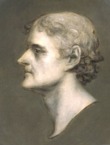
Charles Bird King (American, 1785-1862),
after Gilbert Stuart, Thomas Jefferson, 1836, oil
grisaille on wood
panel, National Portrait Gallery, Washington, DC.
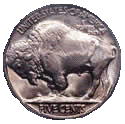
![]()

James Earle Fraser (American, 1876-1953), for the United States of America, Buffalo Nickel, Five Cents, obverse and reverse, 1914, nickel. The profiles of both the American Indian and the bison were sculpted in relief on this coin. The popular legend is that Fraser produced a portrait synthesized from three models: Iron Tail, Big Tree, and Two Moons, each a Native American chief who posed for Fraser in 1911. See numismatics.
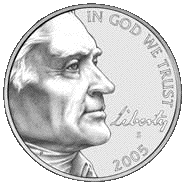
Joe Fitzgerald (American, 1951-), for the United States of America, Nickel, 2005, nickel. This profile view of Jefferson is very close to becoming a three-quarter view.
Also see cameo, frontal, silhouette, and three-quarter view.
program - In painting and sculpture, the conceptual basis of a work. Also, in architecture, an architect's formulation of a design problem with respect to considerations of site, function, materials, and aims of the client.
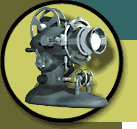 projection
- The process of directing light in
a controlled way. In many cases through a translucent
(usually a filmed, drawn or computer generated) image
and a lens onto a screen or
other viewing surface. Slides
projection
- The process of directing light in
a controlled way. In many cases through a translucent
(usually a filmed, drawn or computer generated) image
and a lens onto a screen or
other viewing surface. Slides 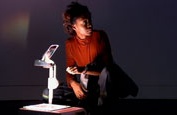 and cinema
are typically projected. Computer,
video, and other images can be as
well.
and cinema
are typically projected. Computer,
video, and other images can be as
well.
Projection can be used as a means to study art, as the end-product of art-making, or as a means by which to produce art. Here is artist Kara Walker (American, 1969-) using an overhead projector to add imagery with large transparencies, and to cause viewers to cast shadows on the silhouette works she places on walls. Also, a projection can be an image projected in this way.
"Projection" can also refer to types of mechanical drawing known as axonometric and oblique projection.
Examples of works involving projection:
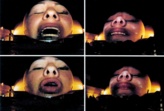
Krzysztof Wodiczko (American, born Poland, 1943-), The Tijuana Projection, 2001, public projection at the Centro Cultural de Tijuana, Mexico (as part of In-Site 2000). Krzysztof Wodiczko creates large-scale slide and video projections of politically-charged images on architectural façades and monuments worldwide. By appropriating public buildings and monuments as backdrops for projections, Wodiczko focuses attention on ways in which architecture and monuments reflect collective memory and history.

Tony Oursler (American, 1957-), MMPI (Self-Portrait in Yellow), 1996,
video installation
with video projector, VCR, video tape, small cloth figure and metal chair, Milwaukee Art Museum,
WI. MMPI stands for the Minnesota Multiphasic Personality Inventory,
a diagnostic tool developed in the 1950s as a test for mental
health. It is based on the discovery that individuals with similar
mental disorders frequently answer the same questions in similar
ways. A projection of the artist's head is seen pinned beneath
the overturned chair, as he answers one of the test's questions
after another.

Paul Pfeiffer (American, 1966-), Fragment of a Crucifixion (After Francis Bacon),
1999, digital video loop, DVD player, miniature projector, and metal
armature; image 3 x 4 inches;
overall, including cables: 20 x 5 x 20 inches (50.8 x 12.7 50.8
cm), Whitney Museum of American Art, NY. See fragment.
Also see atectonic, boss, camera lucida, camera obscura, filter, focus, kaleidoscope, magic lantern, mirror, opaque projector, optical, plan, rugosity, zoetrope, and zoopraxiscope.
projection principle - The phenomenon whereby the imagination is able to create form from any amorphous element, such as clouds, inkblots, etc.
Also see anamorphosis, closure, and visualize.
Prometheus and Promethean - In Greek mythology, Prometheus, one of the Titan giants, modeled humans from clay and then taught them agriculture and all the arts of civilization. He also stole fire from the gods and gave it to humans. So inventive was Prometheus that anything that is notably creative and original may be called "Promethean." Zeus, however, had wanted the human race to perish, so Prometheus' actions were also disobedient. Hence "Promethean" can also mean defiant of authority or limits. As punishment for his disobedience, Zeus chained Prometheus to a rock where an eagle daily ate his liver. Thus, any suffering on a grand scale can also be called Promethean, though this sense is not as common as the others.
(pr. prə-MEE-thee-əs and prə-MEE-thee-ən ["th" as in "think"])
Images of Prometheus:
![]()

![]()
Piero di Cosimo (Italian, 1462-1521), The Myth
of Prometheus, oil,
1515.

Paul Manship (American, 1886-1966), Prometheus,
1934, gilt bronze,
height 18 feet, weight
8 tons, plaza of Rockefeller Center, NY. Its companion piece
is Atlas. See Art
Deco.
Also see avant-garde, and pyrotechnics.
pronaos - In ancient Greek architecture, the space in front of the cella, naos, or body of a Greek temple.
An example:
![]()
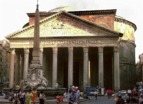
The
Pantheon, Rome, 118 CE.
It consists of a great circular hall
(roofed by a hemispherical
vault), which is entered
by first passing through the pronaos. All sixteen columns
of the pronaos are monoliths
of Egyptian granite. The
pediment was decorated
with reliefs in gilt
bronze as were the internal trabeations of the pronaos. See
pantheon.
proof - In graphic arts, a preliminary print that is examined for quality control before final printing is done.
Example:
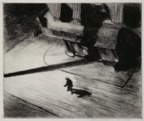
Edward Hopper (American, 1882-1967), Night Shadows, 1921, etching, proof, 6 7/8 x 8 1/4 inches
(17.5 x 21 cm), San Diego Museum of Art, CA. See shadow.
See artist's proof or A.P.
proportion - A principle of design, proportion refers to the comparative, proper, or harmonious relationship of one part to another or to the whole with respect to size, quantity, or degree; a ratio.
Proportion came to English in the Latin word proportionem, meaning comparative relation.
Often proportion is allied with another principle of art, emphasis. For example, if there is a greater number of intense hues than dull hues in a work, emphasis is suggested. For another example, if one figure is made to look larger compared to other figures in a composition, it is said to be out of proportion and is given greater importance.
Examples:
![]()
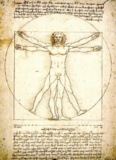
Leonardo da Vinci (Italian, 1452-1519), Study
of proportions, from Vitruvius's De Architectura,
pen and ink,
13 1/2 x 9 5/8 inches (34.3 x 24.5 cm), Accademia, Venice. Leonardo,
inspired by the mathematician
Vitruvius (Roman, 1st century BCE),
drew this famous picture of Vitruvian Man — a sort of ideal
figure — whose arm
span is equal to his height
— a ratio of one, or 1:1.
See a page with a math lesson plan for grades 6-8,
as well as articles on drawing
and Renaissance.



Many schemes for analyzing human proportions
have followed Leonardo's. Among them are those of Adolphe Armand
Braun (1869-?), Proportions
of the Human Figure, Fig. 3 & 4, Numbers 1, 2, 3, & 4, and Proportions
of the Human Head, as published in his Hieroglyphic
or Greek Method of Life Drawing, Postal University/Batsford
London, 1916.
Quote:
Related link:
Also see altered proportion, aspect ratio, distort, elongate, eurythmy, Fibonacci Sequence, golden mean, graph, grid, human scale, scale, and visual scale.
propylaeum - In ancient Greek and Roman architecture, a gateway building leading to an open court preceding a temple. The plural form is propylaea.
(pr. prah-pə-LAY-əm)
proscenium - The stage of an ancient Greek or Roman theater.
(pr. proh-SEE-nee-əm)
prosopopeia - See personification.
prostyle - A style of Greek temple in which the columns stand in front of the cella and extend its full width.
protanomaly - See colorblind or color-blind, or colorblindness.
protanopia - See colorblind or color-blind, or colorblindness.
prototype - An original form that serves as a model on which later stages are based or judged.
An example:
![]()

Eliel Saarinen (American, born Finland, 1873-1950),
designer, Manufacturer International Silver Company, Wilcox Silver
Plate Company Division (Meridan, Connecticut), Prototype Tea Service, c. 1933-35, electroplated nickel
silver, brass, and Bakelite; Tea Urn,
1a-c: 14 1/2 x 7 3/4 inches (36.8 x 19.7 cm) Tray, 2: diameter 17 1/2 inches (44.5 cm) Creamer, 3: 3 x 6 x 3 7/8 inches (7.6
x 15.2 x 9.8 cm) Sugar Bowl, 4a,b: 6 3/4 x 6 x 3 7/8 inches (17.1
x 15.2 x 9.8 cm) Large Tray, 5: diameter 20 1/4 inches (51.4
cm), Metropolitan Museum of Art, NY.
Also see archetype, design, and maquette.
protractor - A semicircular
tool for the measurement and
construction of angles.
On the flat side of the protractor in the middle is either a hole
or cross hairs. This is where the vertex
(point of the angle) must go when measuring. Usually a horizontal
line goes  through
this point and from one side of the protractor to the other. Sometimes
there are no numbers on this line, but 0° or 180° are
measured from here. Along the curved
part of the protractor there are number markings (also called
calibrations), with 90° in the middle. Most protractors have
two sets of numbers for each marking so you can measure an angle
from either side. One set ascends from 0° to 180° — left
to right — and the other set descends from 180° to 0°— right to left. A full circle has 360°. When you line up the
protractor along one side of an angle, it will be lined up at
0° (on either the inner or outer set of numbers). This will
tell you which set of numbers to read.
through
this point and from one side of the protractor to the other. Sometimes
there are no numbers on this line, but 0° or 180° are
measured from here. Along the curved
part of the protractor there are number markings (also called
calibrations), with 90° in the middle. Most protractors have
two sets of numbers for each marking so you can measure an angle
from either side. One set ascends from 0° to 180° — left
to right — and the other set descends from 180° to 0°— right to left. A full circle has 360°. When you line up the
protractor along one side of an angle, it will be lined up at
0° (on either the inner or outer set of numbers). This will
tell you which set of numbers to read.
To measure an angle, put the vertex of the angle at the hole or cross hairs, then turn the protractor so one side of the angle aligns with a zero point. Check to see that the 0° is among the inner or outer sets of numbers, then note the position of the other side of the angle. Where it crosses the curve of the protractor determines the number of degrees (°) of the angle. If your angle has more than 180°, mark the 180° position and measure the additional degrees from there.
A painting inspired by protractors:

Frank Stella, Tahkt-I-Sulayman Variation II, 1969,
acrylic on canvas,
120 x 240 inches, Minneapolis Institute of Arts. In 1967 Frank
Stella began a series of brightly colored paintings based on
the protractor. With the protractor he made three semicircular
designs — the "interlace," the "rainbow"
(seen here), and the "fan" — which he calls variations
I, II, and III. He used these designs as the basis for the many
paintings in the Protractor series. Stella named the paintings
after circular cities and archaeological sites in the Middle
East, where he had traveled in 1963. Takht-i-Sulayman is an ancient
shrine in Azerbaijan, Iran. But Stella insists that the meaning
of his work is purely formal: "My painting is based on the fact that only what can be
seen there is there. It really is an object . . . . You can see
the whole idea without any confusion. What you see is what you
see." See Minimalism.

Frank Stella (American, 1936-), Raqqa II, 1970, synthetic polymer and graphite on canvas, 120 x 300 inches (304.8 x 762 cm), North Carolina Art Museum, Raleigh.
Also see bias, compass, freehand, and mechanical drawing.
provenance - Generally refers to something's place of origin; its source. Used with artworks and antiques, provenance is a record or proof of authenticity or of past ownership.
(pr. PRAH-və-nəns)
Also see context.
Prussian blue - A particular blue pigment.
Related resource:
psalter - A book containing the Psalms of the Bible.
pseudonym - A fictitious name for a person or thing. When used as the name of a person, a pseudonym may or may not have been legally adopted in place of that person's original name. A pseudonym might be a nickname or an alias, and might be noted as "aka" or "also known as." Among writers, a pseudonym is often called a "pen name" or, in French, a nom de plume, often employed when an author would rather not have his or her actual name on a publication. Among actors a pseudonym is called a "stage name" or a "screen name." A number of visual artists have come to be identified more by their pseudonyms than by the names given to them at birth. Reasons for taking a pseudonym often involve economic or political reasons, but as often to have been derived for convenience or from playful whims. A pseudonym might be deemed necessary to shed or disguise a name which is perceived as out of style, or otherwise off-putting; sometimes because it indicates an artist's prominent interest, a physical trait, or regional origin. An artist might adopt a pseudonym when works are of a kind which are very different from works by which the artist is known or wishes to be know.
Example pseudonyms for artists include:
"Donatello" for Donato di Nicolo Bardi (1386-1466), Italian Florentine sculptor. See Renaissance.
"Il Sodoma" for Giovanni Antonio Bazzi (1477-1549), Italian Sienese painter.
"Canaletto" for Giovanni Antonio Canal (1697-1768), Italian painter. See etching and Rococo.
"El Greco" for Doménico Theotocópoulos (1541-1614), Spanish painter who was born in Crete. See Mannerism.
"Grandma Moses" for Anna Mary Robertson Moses (1860-1961), American folk art painter. See feminism and feminist art.
"Giovanni Barbbaro" for Arthur Dudley (exhibited 1890-1907), English painter.
"Le Corbusier" for Charles Edouard Jeanneret (1887-1965), French architect.
"AM Cassandre" for Adolphe Jean-Marie Mouron (1901-1968), Ukrainian-born artist who worked in France and the USA. See diagonal and poster.
"Dr. Seuss" for Theodore Geisel (1904-1991), American children's book illustrator and writer.
"Tom of Finland" for Touko Laaksonen (1920 to 1991), Finnish-American artist.
"Judy Chicago" or "Judy Gerowitz Chicago" for Judy Cohen (1939-), American artist born in Chicago. See feminism and feminist art.
"Sofonisba Anguissola," "Judith Leyster," "Angelica Kauffmann," "Rosa Bonheur," "Berthe Morisot," "Mary Cassatt," "Frida Kahlo," "Eva Hesse," and others for members of the Guerrilla Girls, a contemporary American feminist group founded in 1985, who take pseudonyms from the names of deceased women artists whenever they are interviewed, so that members can be distinguished from each other, but otherwise remain unidentified. See feminism and feminist art.
Also see fame, identity, signature, theater, and unsigned.
pseudorealistic stage - The fifth and last of the Stages of Artistic Development named and described by Victor Lowenfeld, it typically occurs in children during the ages of 11 to 13. This stage is typically preceded by the dawning realism stage (9-11).
Related links:
Also see children's art.
psyker - A Greek vase for cooling wine when it is partly submerged inside of a krater filled with icey water.
An example:
![]()

Greek, Attic, attributed to Oltos, Psykter, c. 520-510 BCE,
Archaic, red-figure, terra
cotta, height 11 7/8 inches
(30.20 cm), Metropolitan Museum of Art, NY.
Also see vessel.
pt. - Abbreviation for pint.
publicity - The spreading of information about something or someone; advertisements, billboards, and news reports, for example.
Also see blockbuster, communication, genius, graphic design, pamphlet, and poster.
Public Works of Art Project (PWAP) - An agency of the U.S. Government during the Great Depression of the 1930s. The Public Works of Art Project (PWAP) in the Civil works Administration (CWA) was among the federal entities which administered New Deal art programs.
puce - Brownish purple. (pron. pyoos)
puddling - A technique of creating even density and eliminating air bubbles in a mix of wet concrete by pushing a rod up and down through the mass.
pug - In ceramics, to mix clay to plasticity.
Also see pug mill.
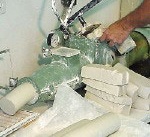
pug mill - A machine with revolving blades that chop, mix, and de-air ceramic clay. The pug mill is used to consolidate clay masses. Pug mills are manufactured in many sizes. Pictured here is a small one that is extruding porcelain.
The pug mill is important equipment in a ceramic studio, but it can also be appropriate in an elementary art classroom where there is a need to recycle clay that does not become pottery on its first use. Pugging clay by hand is tremendously time- and labor-intensive, and storing unusable clay can require considerable space. These are many other reasons using a pug mill to recycle clay may be advantageous for an art education program.
Pug mills have design features that make them safe and easy to use in classrooms.
pull - The graphic artist's term for printing a single print. Hence, "pulling" a print, instead of "printing" a print.
pulpitum - In a Gothic cathedral, a choir screen (see screen). Also called a jubé.
pumice - A light, porous igneous rock, formed from the foam of lava. It is used as an abrasive in both solid and powdered forms, and as a powder it is much used as a polish for marble sculpture.
punch - A tool hammered at right angles into a hard surface such as wood or metal, or pressed by hand into a soft surface such as clay or wax. A punch can cut a ring, or dot, or it can be decorated with a leaf or other such design. Sets of lettered and numbered punches, available in various sizes and styles, can be very useful. Some punches can be described as chasing tools. A punch can also be a broad, pointed metal tool used in roughing out a stone carving.
punctate - Marked with dots or tiny spots; spotted.
Also see ablaq, brindled, pattern, piebald, pointillism, and variegated.
![]()

![]()

![]()
punty - A hollow iron rod used to gather molten glass for blowing; also called a pontil.
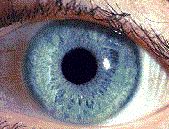
pupil - Physically essential to sight, the hole surrounded by the iris in  the
center of the eye, through which light
passes on its way toward the lens,
through the vitreous humor,
and onto the retina.
the
center of the eye, through which light
passes on its way toward the lens,
through the vitreous humor,
and onto the retina.
(pr. PYOO-pəl)
Example image:
Michelangelo (born Michelangiolo Buonarroti)
(Italian, 1475-1564), the left eye of David, 1501-04, marble,
entire statue 17 feet high, Galleria dell'Accademia, Florence.
The pupil was carved not
to represent its form,
but to
![]()
 represent
its values. The sculptor has retained
a bit of marble inside the pupil in order to create a highlight.
A
represent
its values. The sculptor has retained
a bit of marble inside the pupil in order to create a highlight.
A detail
of David's head,
and a second one. See colossal,
detail, Renaissance, and sculpture.
Stanford Computer Graphics Laboratory, Los Angeles, CA, has recently produced ultra-high-resolution digital images of Michelangelo's David and St. Matthew sculptures.
Related resources:
Also see caruncle, ophthalmology, optical, perception, peripheral vision, and sclera.
puppet, puppeteer, and puppetry - A small-scale figure (as might represent a person or animal) traditionally either one with a cloth body and hollow head that fits over and is manipulated by the hand (aka "glove puppet"), or a marionette — having jointed parts animated from above by strings or wires, or from below by sticks. Bunraku is a traditional type of Japanese puppet. Contemporary puppets are sometimes controlled by electronic devices operated either by humans or computers, via a cable or remote control. These are called "animatronics." A puppet differs from an automaton in that a puppet's motion is caused by a live operator, while an automaton's movements are programmed. Given sufficient imagination, any sort of doll might serve as a puppet. One who operates puppets or who gives puppet shows is a puppeteer. Puppetry is the art of making or operating puppets, a branch of theater.
Examples:
![]()
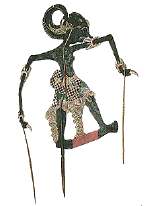
Indonesia, 1800s, Indonesian Shadow Puppets, paint, buffalo
skin, and wood, 28 inches and smaller,
Getty Research Institute, Malibu, CA. These are among 22 objects
in the Devices of Wonder exhibit catalogued online
by the Getty Museum — best seen with Flash and RealAudio plugins. This is Prince Bima, one of the sons of King Pandu.

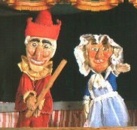
Arthur Rose (aka Prof. Rozella, English, early 20th century), Punch and Judy in their theater (also known as a "pitch"), and another
Punch by Harry Smith (Canadian), early 20th century, hand puppets. The marionette or hand (glove) puppet figures of Punch and Judy are the main characters in a long tradition of puppets across Europe. "Punch" is the shortened form of the English Punchinello, which in turn was taken from the Italian Policianelo or Pulcinella, and the French Polichinelle, a character in the Italian Commedia dell'arte. His features include a large hooked nose, protruding chin, reddened nose and cheeks, and humped back. The masked characters of the Commedia dell'arte, in turn, derive from specific characters of the Roman Atellan farces, which likely descended from characters in Asian and Middle Eastern lore. See mask.
![]()
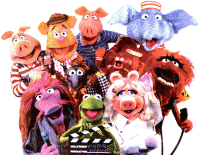
Jim Henson (American, 1936-1990), Kermit the Frog, Miss Piggy, and other Muppets, 1969-, hand puppets, many of which have appeared on the children's television program Sesame Street from its beginning in 1969.
Resources concerning puppetry:
Also see anthropomorphism, costume, dance, mannequin, mask, new media, and video.
purple - A mixture of red and violet hues, the only color on a conventional twelve-color color wheel that is not natural to the visible spectrum. A rare form of the word purple is purpure.
purpure - See purple.
push and pull - An optical sensation colors cause: the impression that each hue appears to recede or advance to a different depth from the eye. This term was coined and the concept promoted by painter Hans Hofmann (born in Bavaria, active in the USA, 1880-1966), often associated with Abstract Expressionism. His late paintings are characterised by the juxtaposition of strongly colored rectangles, which he said displayed this push and pull effect. The paintings were often worked out by pinning rectangles of colored paper to the canvas.
Examples:
![]()

![]()
Hans Hofmann, Pompeii, 1959, oil
on canvas, 214.0 x 132.7 cm,
Tate Gallery, London.

Hans Hofmann, Simplex Munditis, 1962, oil
on canvas, 84 x 72 inches,
Santa Barbara Museum of Art, CA.
putto - A very young nude child, typically male. Putti (the plural form) were favorite subjects of Italian Renaissance and Baroque painting and sculpture.
(pr. POO-toh and POO-tee)
putty rubber - Alternative name for a kneaded eraser.
PVA - An abbreviation for polyvinyl alcohol. PVA is a thick white liquid which dries to a tough clear plastic skin. It is an adhesive and may also be used diluted with water as a release agent or sealant.
PVC - An abbreviation for polyvinyl chloride. PVC is a flexible sheet plastic which can be sewn, glued, or welded. Shapes made from PVC may be stuffed, inflated or filled with water. Inexpensive plastic pipes, and their related fittings, commonly used by plumbers, are usually made of PVC.
Also see inflatable.
PWAP - An acronym for the Public Works of Art Project. The PWAP in the Civil works Administration (CWA) were among the "alphabet soup" of federal projects which administered New Deal art programs during the Great Depression of the 1930s.
Pygmalion - A Cypriot sculptor in a legend that Ovid retold in his Metamorphoses. Pygmalion fell in love with a marble statue he'd carved of a beautiful woman named Galatea. Pygmalion prayed to Venus that the figure would come to life. When Venus granted Pygmalion's wish, the statue of Galatea came to life and returned his love.
(pr. pig-MAY-lee-ən)
Two depictions of Pygmalion and Galatea:

![]()
Anne-Louis Girodet De Roussy-Trioson (French, 1767-1824), Pygmalion and Galatea, oil on canvas, exhibited in the
Paris Salon of 1819, 2.53 x 2.02 m, Louvre.

![]()
Jean-Léon Gérôme (French,
1824-1904), Pygmalion and Galatea, c. 1890, oil
on canvas, 35 x 27 inches
(88.9 x 68.6 cm), Metropolitan Museum of Art, NY.
pylon - The monumental entrance to an ancient Egyptian temple.
(pr. PI:-lahn)
Also see hypostyle hall.
pyrometer - A mechanical device for measuring the temperature in a kiln.
pyrometric cones - Ceramic clay wedges placed inside a kiln before firing. (Bar shapes are also available.) At a certain temperature a cone will bend, so by constant observation it can be determined at what point particular temperatures are reached in the kiln. Used in a Kiln-Sitter, electricity is turned off to the kiln when the cone placed in it bends. The E. Orton Jr. Ceramic Foundation advises using a particular set of temperature equivalents for their cones, which melt at 34 different temperatures, each identified with its own cone number: starting at 022 at the lowest temperature (1157 degrees F.), continuing to cone 01, then to cone 1, and to the hotest at cone 12 (about 2420 degrees). Orton cones come in two regular sizes, temperatures varying between them slightly, rarely significantly. Number 06 large regular cones bend at 1830 degrees F., and small regular cones at 1873. Number 04 large regular cones bend at 1940, and small regular cones at 2008. Clay must be fired at a higher temperature to bisque than any subsequent firing for glazes. A triangle is often used as a glyph for "cone."
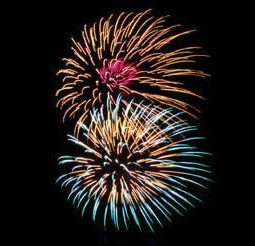
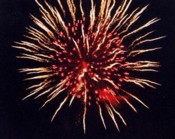
pyrotechnics - Literally "measured fires," the craft of manufacturing or setting off fireworks, a display of fireworks, or a brilliant display — such as of wit, or of virtuosity in the arts. A person who has expertise in this field is a pyrotechnist.
![]()


Photo of a grand finale. Photo of a different one.
Example of pyrotechnics as a subject of art:

![]()
James Abbott McNeil Whistler (American, 1834-1903),
Nocturne in Black and Gold: The Falling Rocket,
c. 1874, oil on canvas,
23 3/4 x 18 3/8 inches, Detroit Institute of Arts. Whistler's
nocturnes were tangible demonstrations of his creed of aestheticism,
which stressed the artist's duty to orchestrate selected elements
from nature
into a composition
that, like music, existed
for its own sake, without regard to moral or didactic
issues. This controversial
viewpoint (Whistler was known for verbal as well as visual pyrotechnics)
led to a lawsuit with John Ruskin, which bankrupted Whistler,
but assured him of a distinguished place as a precurser of abstract art. Also see art
for art's sake and fin de siècle.
Also see nocturne and Prometheus.
pyroxilin - See Duco.
pyx - A small round lidded-box in which Catholic priests store consecrated hosts.
Related link:
The Glossary of Medieval Art and Architecture defines pyx and provides an illustration.
Also see pyxis.
pyxis - A ceramic vessel used by the ancient Greeks to store cosmetics and perfumes. The plural form is pyxides. Among the other types of Greek vases are the alabastron, amphora, hydria, pelike, kantharos, krater, kyathos, kylix, lekythos, oinochoe, pelike, phiale, pinax, pithos, and rhyton.
Example:

Greece, Attica, Eretria Painter, Pyxis with lid, c. 430 BCE,
slip decorated
terra cotta, Worcester Art Museum,
MA. The lid of this pyxis is decorated with two pairs of playful
Erotes, the companions of Aphrodite at play, while the container
displays vignettes of an aristocratic woman at leisure in her
home — an idealized depiction of daily life for Athenian upper-class
women.
Also see pyx.
https://inform.quest/_art